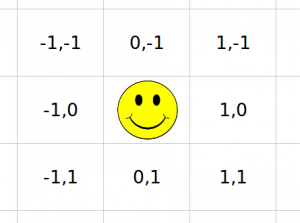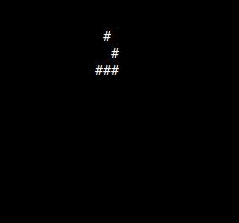The Game of Life, created by John Conway in 1970, is probably the most well known cellular automata. Implemented on a grid it has a few very simple rules that are imposed at each cycle:
1. Any cell with fewer than two live neighbors dies
2. Any living cell with two or three living neighbors lives
3. Any living cell with more than three living neighbors dies
4. Any dead cell with exactly three living neighbors becomes a living cell
While there are many different types of cellular automata I’ve decided to use this one for a few reasons: it’s very well known, easy to code, and most importantly it is Turing complete so anything that can be computed can be done within the Game of Life (GOL).
The algorithm for the game of life is shown in the following pseudo-code:
#Declarations
rows = 40 #num rows of matrix
columns = 80 #num columns of matrix
fps = 20 #number of frames per second to display
cycles = 500 #number of simulation iterations
use_seed = 1 #0=no, 1=yes
#define locations of 8 neighbor cells
neighbors = [[-1,-1],[0,-1],[1,-1],[-1,0],[1,0],[-1,1],[0,1],[1,1]]
seed = [[0,0,1], #glider
[1,0,1],
[0,1,1]]
#seed = [[0,1,0], #blinker
# [0,1,0],
# [0,1,0]]
#Initialize currentState = populate(rows, columns, use_seed, 3, 3, seed)
def populate(numR, numC, use_seed, insertR, insertC, seed):
#populate either with a seed or with random 1s and 0s
if use_seed == 0:
#Populate with random field of 1s and 0s
currentState = [[random.randint(0,1) for i in range(numC)] for j in range(numR)]
else:
#Populate with seed
currentState = [[0 for i in range(numC)] for j in range(numR)]
nextState = [[0 for i in range(numC)] for j in range(numR)]
Cseed = len(seed[0])
Rseed = len(seed)
for i in range(Rseed):
for j in range(Cseed):
currentState[insertR+i][insertC+j] = seed[i][j]
return currentState
#Main
print "Running"
for i in range(cycles):
currentState = update_state(currentState, neighbors)
#print "Cycle ", i
display(currentState,fps)
print "Done"
def update_state(currentState, neighbors):
'''
this function is where the actual game of life calculations happen
for each cell
count = 0
for each neighbor
if currentState == alive
count = ++
if count == 3
nextState = alive
else if count != 2 or 3
nextState = dead
'''
nextState = copy.deepcopy(currentState)
Rindex = 0
for row in currentState:
Cindex = 0
for cell in row:
count = 0
for neighbor in neighbors:
# % does modulo indexing to create toroidal universe
neighborR = (Rindex + neighbor[1]) % len(currentState)
neighborC = (Cindex + neighbor[0]) % len(currentState[0])
if currentState[neighborR][neighborC] == 1:
count += 1
if count == 3:
nextState[Rindex][Cindex] = 1
elif count != (2 or 3):
nextState[Rindex][Cindex] = 0
Cindex += 1
Rindex += 1
return nextState
def display(universe, fps):
#very simple routine to display animated cell state in terminal
#calculate time to sleep
sleepTime = 1.0/fps
#clear screen and reposition cursor
sys.stderr.write("\x1b[2J\x1b[H")
for row in universe:
for column in row:
if column == 0:
#leave empty for 0
sys.stdout.write(' ')
else:
#fill in for 1
sys.stdout.write('#')
print "\r"
sys.stdout.flush()
time.sleep(sleepTime)
sys.stderr.write("\x1b[2J\x1b[H") #clear screen and reposition cursor
# vim: tabstop=8 expandtab shiftwidth=4 softtabstop=4
'''
Chad Bonner Nov.23.2013
Game of Life
'''
#Module import
import copy
import sys
import time
import random
# Function Definitions
def update_state(currentState, neighbors):
'''
this function is where the actual game of life calculations happen
for each cell
count = 0
for each neighbor
if currentState == alive
count = ++
if count == 3
nextState = alive
else if count != 2 or 3
nextState = dead
'''
nextState = copy.deepcopy(currentState)
Rindex = 0
for row in currentState:
Cindex = 0
for cell in row:
count = 0
for neighbor in neighbors:
# % does modulo indexing to create toroidal universe
neighborR = (Rindex + neighbor[1]) % len(currentState)
neighborC = (Cindex + neighbor[0]) % len(currentState[0])
if currentState[neighborR][neighborC] == 1:
count += 1
if count == 3:
nextState[Rindex][Cindex] = 1
elif count != (2 or 3):
nextState[Rindex][Cindex] = 0
Cindex += 1
Rindex += 1
return nextState
def display(universe, fps):
#very simple routine to display animated cell state in terminal
#calculate time to sleep
sleepTime = 1.0/fps
#clear screen and reposition cursor
sys.stderr.write("\x1b[2J\x1b[H")
for row in universe:
for column in row:
if column == 0:
#leave empty for 0
sys.stdout.write(' ')
else:
#fill in for 1
sys.stdout.write('#')
print "\r"
sys.stdout.flush()
time.sleep(sleepTime)
def populate(numR, numC, use_seed, insertR, insertC, seed):
#populate either with a seed or with random 1s and 0s
if use_seed == 0:
#Populate with random field of 1s and 0s
currentState = [[random.randint(0,1) for i in range(numC)] for j in range(numR)]
else:
#Populate with seed
currentState = [[0 for i in range(numC)] for j in range(numR)]
nextState = [[0 for i in range(numC)] for j in range(numR)]
Cseed = len(seed[0])
Rseed = len(seed)
for i in range(Rseed):
for j in range(Cseed):
currentState[insertR+i][insertC+j] = seed[i][j]
return currentState
#Declarations
rows = 40 #num rows of matrix
columns = 80 #num columns of matrix
fps = 1 #number of frames per second to display
cycles = 500 #number of simulation iterations
use_seed = 0 #0=no, 1=yes
#define locations of 8 neighbor cells
neighbors = [[-1,-1],[0,-1],[1,-1],[-1,0],[1,0],[-1,1],[0,1],[1,1]]
seed = [[0,0,1], #glider
[1,0,1],
[0,1,1]]
#seed = [[0,1,0], #blinker
# [0,1,0],
# [0,1,0]]
#Initialize
currentState = populate(rows, columns, use_seed, 3, 3, seed)
#Main
print "Running"
for i in range(cycles):
currentState = update_state(currentState, neighbors)
#print "Cycle ", i
display(currentState,fps)
print "Done"



Comments:2
Leave a Reply